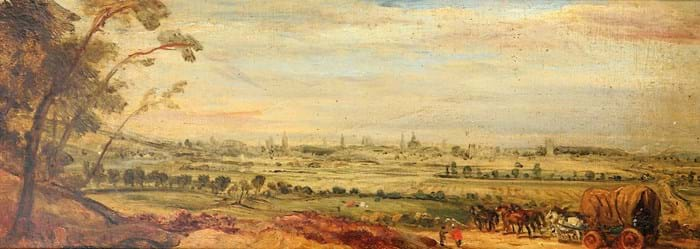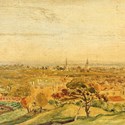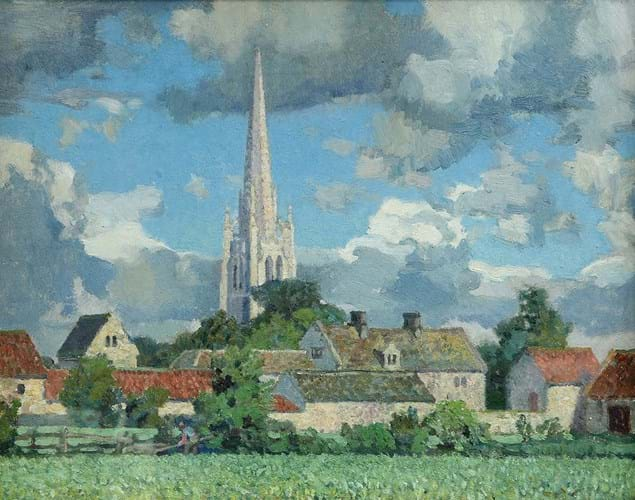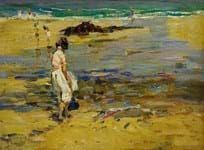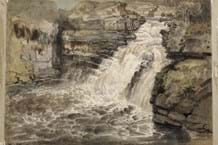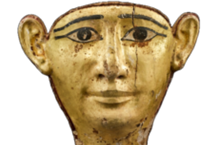Unidentified works and rediscoveries are crucial in keeping the art market ticking over, especially in more traditional sectors where the supply of the all-important fresh material is leaner.
It’s worth remembering that when an unattributed work sells well it not just the vendor that receives a windfall. The auction house takes a cut and if a dealer buys it, researches it, and then sells it on, they will also make a return that in turn can be reinvested in other works.
This process could loosely be described as the art market’s version of the multiplier effect (a concept beloved of economists).
Such an example came up in Ripon, North Yorkshire, recently when a pair of 19th century landscape paintings caused a significant stir at the Autumn Fine Art & Antiques sale held by Elstob & Elstob (22% buyer’s premium).
The two works were offered on October 29-31 as part of a large group of items from a client in the Lake District but with seemingly nothing known about their history.
Distant views
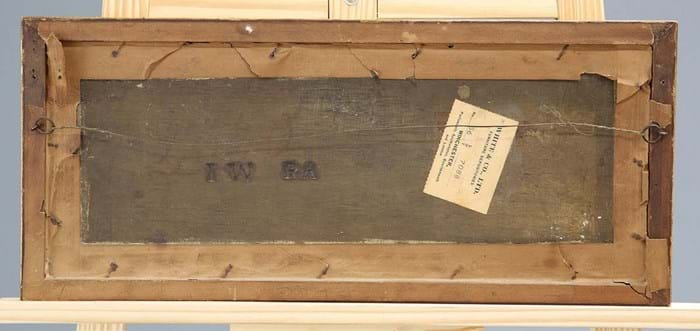
Catalogued as ‘English school (19th century)’, two landscapes were stamped IW RA on the back, probably referring to James Ward (1769-1859). They sold as a single lot for £22,500 at Elstob & Elstob.
The oils on board were framed, with the largest measuring 6 x 16½in (15.5 x 42cm).
While it was felt they were not without quality, the identity of the artist was unclear and they were catalogued simply as ‘English school (19th century)’ and estimated at £300-400 as a single lot.
However, a number of parties eyed them up before the sale and were prepared to go to considerable lengths to acquire them, leading to a prolonged competition on the day.
“It was incredibly exciting to watch the bidding for the paintings unfold,” said director at the auction house David Elstob. “Quite a few people showed an early interest in the paintings but as the price climbed into the thousands, it fell to two bidders – one on the phone and one in the room – who fought it out between them.”
The lot was eventually knocked down at £22,500 to a London dealer who it is understood will now conduct research into the works and may well reveal more about them in due course. As for why they fetched this price, a major clue came from the fact that they were stamped on the back IW RA. A number of bidders realised this was likely to be a reference for James Ward (1769- 1859), the London-born painter and printmaker.
Indeed, it was not unknown for Wards’ pictures to be branded IW or IWRA on the back of the panels to stop unscrupulous dealers from changing the attribution to that of his brother-in-law George Morland (whose style his works followed in his early years).
Today Ward remains admired for his powers of observation – which were honed by his work as an engraver – but arguably he has been overlooked on the market compared to some of his contemporaries.
Works appear relatively often but only the best tend to make strong five-figure prices and even, on occasion, six figures. Animal subjects tend to be the most valuable, followed by landscapes.
Oil sketches
The size of the current pictures indicated these were oil sketches for larger works. One of the works, showing the highly identifiable King’s College Chapel in Cambridge to the far right, was seemingly a study for a larger c.1840 painting of the same view of the city from the top of Castle Hill (a work acquired by the Museum of Cambridge in 2016).
The other picture appeared to show the outline of Oxford’s Magdalen Tower, the spire of St Mary’s University Church and the Radcliffe Camera to the background, suggesting that, like its companion picture, it was created en plein air but here perhaps from Hinksey Hill.
While it is difficult to quantify how much difference the subject of the university towns added commercially, it seems likely to have been considerable. The fact that they were original and untouched condition (although somewhat grubby) added to their appeal.
The price at Elstob & Elstob was the highest for Ward since The Falls of the Clyde After a Flood, a much larger oil painting, made £24,000 at Sotheby’s in February 2019. One specialist dealer in 19th century British pictures thought that while the price would be strong for generic landscapes by the artist, for views of these university towns they may well prove to be good value.
The result, though, was something of a landmark for the auction house which itself is just over 18 months old.
It was a house record for a picture and helped Elstob & Elstob to post its highest overall total for a sale so far.
Morthen but northern
Another picture bringing demand in Ripon but further down the price scale was Laughton en le Morthen by Stanley Royle (1888-1961). Despite its French-sounding name, the town depicted is in South Yorkshire, about 20 miles south-east of Rotherham.
The artist mainly produced landscapes around Yorkshire but also Canada, to where he emigrated in 1931, taking up a post at the Nova Scotia School of Art.
The picture here, a 15½ x 19¼in (39 x 49cm) oil on board that was signed and dated 1946, featured the large spire of Laughton’s All Saints Church prominently.
This helped it exceed the £1500- 2500 estimate and it was knocked down at £2600 – a decent sum for a work of this size.


